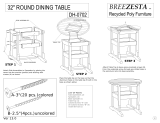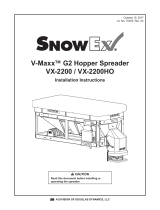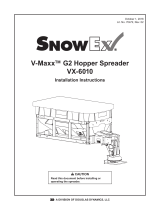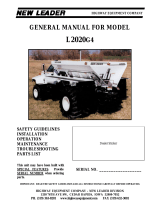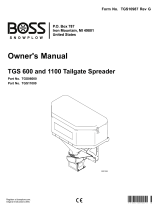Page is loading ...

November 15, 2016
Lit. No. 13666, Rev. 06
CAUTION
Read Owner's Manual before operating or
servicing spreader.
A DIVISION OF DOUGLAS DYNAMICS, LLC
In-Bed Mount
For Single- and Two-Stage Tailgate Spreaders
Installation Instructions

Lit. No. 13666, Rev. 06 2 November 15, 2016
SAFETY
SAFETY DEFINITIONS
NOTE: Indicates a situation or action that can lead
to damage to your spreader and vehicle or other
property. Other useful information can also be
described.
WARNING
Indicates a potentially hazardous situation
that, if not avoided, could result in death or
serious personal injury.
CAUTION
Indicates a potentially hazardous situation
that, if not avoided, may result in minor to
moderate injury. It may also be used to alert
against unsafe practices.
WARNING
• Driver to keep bystanders minimum of
25 feet away from operating spreader.
• Before working with the spreader, secure all
loose-tting clothing and unrestrained hair.
• Before operating the spreader, verify that all
safety guards are in place.
• Before servicing the spreader, wait for
conveyor or spinner to stop, then lock out
power.
• Do not climb into or ride on spreader.
CAUTION
If rear directional, CHMSL light or brake
stoplights are obstructed by the spreader,
the lights shall be relocated, or auxiliary
directional or brake stoplights shall be
installed.
CAUTION
During the hopper installation we recommend
the addition of an OSHA compliant Backup
Alarm. This alarm is required for OSHA
governed employers.
SAFETY PRECAUTIONS
Park the vehicle on a level surface, place shift lever in
PARK or NEUTRAL and set the parking brake. Turn
OFF the engine and remove keys.
WARNING
Overloading could result in an
accident or damage. Do not exceed
GVWR or GAWR ratings as found
on the driver-side vehicle door
cornerpost. See Loading section to determine
maximum volumes of spreading material.

Lit. No. 13666, Rev. 06 3 November 15, 2016
FIRE AND EXPLOSION
Be careful when using gasoline. Do not use gasoline
to clean parts. Store only in approved containers away
from sources of heat or ame.
CELL PHONES
A driver's rst responsibility is the safe operation of
the vehicle. The most important thing you can do
to prevent a crash is to avoid distractions and pay
attention to the road. Wait until it is safe to operate
Mobile Communication Equipment such as cell
phones, text messaging devices, pagers or two‑way
radios.
VENTILATION
BATTERY SAFETY
NOTE: Lubricate grease ttings after each use.
Use a good quality multipurpose grease.
PERSONAL SAFETY
• Remove ignition key and put the vehicle in park or
in gear to prevent others from starting the vehicle
during installation or service.
• Wear only snug-tting clothing while working on
your vehicle or spreader.
• Do not wear jewelry or a necktie, and secure long
hair.
• Wear safety goggles to protect your eyes from
battery acid, gasoline, dirt and dust.
• Avoid touching hot surfaces such as the engine,
radiator, hoses and exhaust pipes.
• Always have a re extinguisher rated BC handy,
for ammable liquids and electrical res.
SAFETY
CAUTION
Disconnect electric and/or hydraulic power
and tag out if required before servicing or
performing maintenance.
CAUTION
• Do not operate a spreader in need of
maintenance.
• Before operating the spreader, reassemble
any parts or hardware removed for cleaning
or adjusting.
• Before operating the spreader, remove
materials such as cleaning rags, brushes,
and hand tools from the spreader.
• While operating the spreader, use auxiliary
warning lights, except when prohibited by law.
• Tighten all fasteners according to the
Torque Chart. Refer to Torque Chart for the
recommended torque values.
CAUTION
Batteries normally produce explosive gases,
which can cause personal injury. Therefore,
do not allow ames, sparks, or lit tobacco
to come near battery. When charging or
working near a battery, always cover your
face and protect your eyes, and also provide
ventilation.
• Batteries contain sulfuric acid, which burns
skin, eyes and clothing.
• Disconnect the battery before removing or
replacing any electrical components.
WARNING
Vehicle exhaust contains lethal fumes.
Breathing these fumes, even in low
concentrations, can cause death. Never
operate a vehicle in an enclosed area without
venting exhaust to the outside.
WARNING
Gasoline is highly ammable and gasoline
vapor is explosive. Never smoke while
working on vehicle. Keep all open ames
away from gasoline tank and lines. Wipe up
any spilled gasoline immediately.
CAUTION
DO NOT leave unused material in
hopper. Material can freeze or solidify,
causing unit to not work properly.
Empty and clean after each use.

Lit. No. 13666, Rev. 06 4 November 15, 2016
NOISE
Airborne noise emission during use is below 70 dB(A)
for the spreader operator.
VIBRATION
Operating snowplow vibration does not exceed
2.5 m/s2 to the hand‑arm or 0.5 m/s2 to the whole
body.
1/4-20 10
91
54
1/4-28 12
11
71
5/16-1
81
50 212
5/16-2
41
70 240
3/8-16 269 376
3/8-24 29
74
20
7/16-1442
96
06
7/16-20
9/16-12
9/16-18
5/8-11
5/8-18
3/4-10
3/4-16
7/8-9
7/8-14 47
46
69
64
49
091-8
1-12 70
49
95
1/2-13
1/2-20
11.9
13.7
24.6
27.3
43.6
26.9
53.3
93
148
49.4
69.8
77.9
106.4
120.0
8.4
9.7
17.4
19.2
30.8
35.0
49.4
55.2
75.3
85.0
M6 x 1.00
M12 x 1.75
M8 x 1.25
M14 x 2.00
M10 x 1.50
M27 x 3.00
M22 x 2.50
M30 x 3.50
M24 x 3.00
M20 x 2.5011.1
19.5
38.5
67
107
7.7
613
778
1139
1545
450
428
562
796
1117
M33 x 3.50
M36 x 4.00
2101
2701
1468
1952
325
M16 x 2.00 231167
M18 x 2.50 318222
Recommended Fastener Torque Chart
Size Size
Torque (ft-lb)
Grade
5
Grade
8
Metric Fasteners Class 8.8 and 10.9
These torque values apply to fasteners
except those noted in the instructions.
Torque (ft-lb)
Grade
5
Grade
8
Size Size
Torque (ft-lb)
Class
8.8
Class
10.9
Torque (ft-lb)
Class
8.8
Class
10.9
Inch Fasteners Grade 5 and Grade 8
CAUTION
Read instructions before assembling.
Fasteners should be nger tight until
instructed to tighten according to torque
chart. Use standard methods and practices
when attaching spreader, including proper
personal protective safety equipment.
SAFETY
TORQUE CHART

Lit. No. 13666, Rev. 06 5 November 15, 2016
These instructions cover vehicles recommended for
carrying the spreader. Please see your sales outlet for
proper vehicle applications.
CERTIFICATION
LOADING
10 ft
3
3.9 ft3
WARNING
New untitled vehicle installation of a spreader
requires National Highway Trafc Safety
Administration altered vehicle certication
labeling. Installer to verify that struck load of
snow or ice control material does not exceed
GVWR or GAWR rating label and complies
with FMVSS.
WARNING
Overloading could result in an accident or
damage. Do not exceed GVWR or GAWR
ratings as found on the driver-side cornerpost
of vehicle. See Loading section to determine
maximum volumes of spreading material.
CAUTION
Read and adhere to manufacturer's ice-
control material package labeling including
Material Safety Data Sheet requirements.
MATERIAL WEIGHTS
Density
Material (lb/ft3)(lb/yd3)(kg/m3)
Salt 80 2160 1282
Sand 100 2700 1602
Material densities are approximate and are based on dry
loose material. It is the responsibility of the operator to
know the weight of the material to be spread and the vehicle
carrying capacity.

Lit. No. 13666, Rev. 06 6 November 15, 2016
6. Loosely assemble the mount assembly by
connecting the trusses. Use the two cross braces
and ve 3/8" x 1-1/4" cap screws and locknuts.
7. Place the mount assembly into the vehicle bed
with clearance between the rear of the mount
assembly and the rearmost obstruction of the
vehicle (bumper, hitch, etc.).
8. Position the back angle with the longer leg
pointing down against the back of the bed and
below the mount assembly.
9. Connect the back angle to the truss assembly
using two 3/8" x 1-1/2" cap screws and locknuts.
Insert the bolts from the bottom up. Tighten, but
do not torque these bolts at this time.
IN-BED MOUNT INSTALLATION
In-Bed Mount Installation
NOTE: Remove any existing trailer hitch and other
after-market equipment that may interfere with
the installation of this product according to these
instructions.
The in‑bed mount can be installed in most pickup
truck boxes which are in good condition. The
telescoping frame members and various attachment
methods will work for most situations.
Mount Assembly
1. Remove all of the mount assembly hardware from
the shipping carton. Verify no parts are missing.
2. Remove the tailgate from the vehicle.
3. Slide the telescopic top tube into the top tube.
4. Slide the telescopic bottom tube into the truss.
5. Loosely attach the top tube to the truss and the
telescopic top tube to the telescopic bottom tube
using four 1/2" x 3" cap screws and locknuts.
NOTE: Attach the top tube to the truss with
dimples facing up.
3/8" x 1-1/4"
Cap Screw 1/2" x 3"
Cap Screw
Truss
Driver
Side
Cross
Brace
Truss
Passenger
Side
Mount Assembly
Vehicle Bed
Back Angle
3/8" x 1-1/2" Cap Screws
Bumper
Check for Clearance

Lit. No. 13666, Rev. 06 7 November 15, 2016
Channel Installation
Establish Channel Position Range
1. Position the back angle against the rear of the
vehicle bed and telescope the telescopic tubes to
their shortest length.
2. Measure the distance from the back angle to the
vertical hole in the front of the truss tube. This is
the minimum position of the range. The minimum
position plus 16 inches is the maximum position of
the range.
NOTE: The channel attachment hardware must be
assembled to the vehicle frame within the position
range.
Channel Attachment Hardware Location
1. Inspect the area of the frame within the position
range of the mount assembly as determined in the
previous section.
2. Select a location for the channel attachment
hardware that is free from obstructions and
is suited to one of following three installation
methods. Ideally, this location should be below a
bed support channel.
IN-BED MOUNT INSTALLATION
The three methods of securing the channel to the
frame on most vehicles, as required by vehicle t-
up, are listed from most recommended to least
recommended.
1. Angle Bracket Method
• An angle bracket is bolted to the outside of the
vehicle frame. One carriage bolt is used on each
side.
• Use this method if there is an existing 1/2" hole
in the vehicle frame or there is clearance for one
1/2" hole to be drilled.
CAUTION
If location chosen for mount channel is not
above a bed support channel, a hardwood
block MUST be placed between the frame
and the vehicle bed to prevent collapsing of
the bed. This should be held in place by one
carriage bolt coming through the bed. Wood
blocks are provided for this and may be cut to
the required height.

Lit. No. 13666, Rev. 06 8 November 15, 2016
IN-BED MOUNT INSTALLATION
2. Strap Method
• A strap straddles the vehicle frame and is held in
place with two carriage bolts.
• Use this method if there is clearance on both sides
of the vehicle frame but little clearance for drilling
holes in the vehicle frame.
3. Frame Flange Method
• A hole is drilled through the ange of the vehicle
frame. One carriage bolt is bolted to the frame
ange on each side.
• Recommended only for vehicles which do not
accommodate one of the previous two options.
Angle Bracket Method
1. Inspect both sides of the frame and underside of
the truck bed for an area that does not have any
obstructions for the carriage bolts that will pass
through from the channel on top of the bed oor to
the angle brackets mounted to the frame rails. Be
sure this area is within the position range of the
telescopic truss tubes.
2. On each side of the vehicle bed, drill a 5/8" hole
located 1" outside the vehicle frame.
NOTE: Pay special attention when drilling or
clamping dissimilar metals to aluminum bodies.
Galvanic corrosion can occur if not handled
properly. Contact vehicle manufacturer for
recommended attachment practices.
3. Place a 1/2" x 14" carriage bolt through each hole
in the bed.
4. Using the carriage bolts as a reference, locate
the positions for the angle brackets on the vehicle
frame. Remove the carriage bolts.
CAUTION
Before drilling holes, check to be sure that no
vehicle wiring or other components could be
damaged.

Lit. No. 13666, Rev. 06 9 November 15, 2016
IN-BED MOUNT INSTALLATION
5. Use an existing 1/2" hole in the vehicle frame
to mount the angle bracket. Center the angle
brackets vertically on the vehicle frame. If there
is no hole, use the angle bracket as a template to
mark a hole position.
6. Remove the angle bracket and drill one 1/2" hole
on each side of the vehicle frame.
NOTE: Pay special attention when drilling or
clamping dissimilar metals to aluminum bodies.
Galvanic corrosion can occur if not handled
properly. Contact vehicle manufacturer for
recommended attachment practices.
7. Attach the angle brackets with the larger 5/8" hole
facing down using one 1/2" x 2" cap screw and top
lock ange locknut on each side.
8. Insert bolts from the outside of the vehicle frame.
Tighten according to the torque chart.
9. Center the channel over the drilled holes in the
vehicle bed.
10. Insert one 1/2" x 14" or 1/2" x 6-1/2" carriage
bolt on each side through the slots in the mount
channel, the holes drilled in the truck bed, the
wood block (if required), and through the angle
brackets.
11. Secure the channel using one 1/2" top lock ange
locknut on each side below the angle bracket.
Verify the channel is still centered side‑to‑side in
the vehicle bed and parallel with the back of the
bed.
12. Tighten the carriage bolts according to the torque
chart, alternating sides as you tighten.
13. Cut off excess bolt thread to provide clearance
for exhaust, suspension, etc. Proceed to Mount
Installation.
1/2" x 2" Cap Screw
1/2" x 14" or
1/2" x 6-1/2"
Carriage Bolt
CAUTION
Before drilling holes, check to be sure that no
vehicle wiring or other components could be
damaged.

Lit. No. 13666, Rev. 06 10 November 15, 2016
6. Insert two 1/2" x 14" carriage bolts on each side
through the slots in the channel and through the
holes drilled in the vehicle bed.
NOTE: The carriage bolt on the outside of the
vehicle frame should also pass through the wood
block (if required).
7. Slide the strap onto the bolts and secure with two
top lock ange locknuts on each side.
8. Make sure the channel is still centered side to side
in the vehicle bed and parallel with the back of the
vehicle bed. Tighten the carriage bolts according
to the torque chart, alternating sides as you
tighten.
9. Cut off excess bolt thread to provide clearance
for exhaust, suspension, etc. Proceed to Mount
Installation.
IN-BED MOUNT INSTALLATION
Strap Method
1. Inspect both sides of the frame and underside of
the truck bed for an area that does not have any
obstructions for the carriage bolts that will pass
through from the channel on top of the bed oor
to the bottom of the frame rails. Be sure this area
is within the position range of the telescopic truss
tubes.
2. On each side of the vehicle bed, drill a 5/8" hole
located 1/2" outside the vehicle frame.
NOTE: Pay special attention when drilling or
clamping dissimilar metals to aluminum bodies.
Galvanic corrosion can occur if not handled
properly. Contact vehicle manufacturer for
recommended attachment practices.
3. Mark a position for one 5/8" hole located
1/2" inside the vehicle frame on each side. DO
NOT drill the hole at this time. Locate a second
hole position 15-1/4" from the centerline of the
vehicle bed on each side.
4. Drill one 5/8" hole on each side at the hole
positions closest to the centerline of the vehicle
bed.
5. Place the channel over the drilled holes and
center it from side to side.
1/2" x 14"
Carriage Bolt
Carriage Bolts
Strap
CAUTION
Before drilling holes, check to be sure that no
vehicle wiring or other components could be
damaged.
Approx.
1/2"

Lit. No. 13666, Rev. 06 11 November 15, 2016
IN-BED MOUNT INSTALLATION
CAUTION
Before drilling holes, check to be sure that no
vehicle wiring or other components could be
damaged.
Frame Flange Method
1. Inspect both sides of the frame and underside of
the truck bed for an area that does not have any
obstructions for the carriage bolts that will pass
through from the channel on top of the bed oor
to the top of the frame rails. Be sure this area is
within the position range of the telescopic truss
tubes.
2. On each side of the vehicle bed, drill one 5/8" hole
extending through the center of the top ange of
the vehicle frame.
NOTE: Pay special attention when drilling or
clamping dissimilar metals to aluminum bodies.
Galvanic corrosion can occur if not handled
properly. Contact vehicle manufacturer for
recommended attachment practices.
3. Place the mount channel over the drilled holes
and center it from side to side.
4. Insert one 1/2" x 6-1/2" carriage bolt on each side
through slots in the channel, through the holes
drilled in the vehicle bed, through the wood block
(if required), and through the holes drilled in the
vehicle frame.
5. Secure the channel using one 1/2" top lock ange
locknut on each side.
6. Verify the channel is still centered side to side in
the vehicle bed and parallel with the back of the
vehicle bed.
7. Tighten the carriage bolts according to the torque
chart, alternating sides as you tighten.
8. Cut off excess bolt thread to provide clearance
for exhaust, suspension, etc. Proceed to Mount
Installation.
1/2" Top Lock
Flange Nut
1/2" x 6-1/2"
Carriage Bolt

Lit. No. 13666, Rev. 06 12 November 15, 2016
MOUNT INSTALLATION
Attach Wood Board To Mount Assembly
1. Place the mount assembly in the vehicle bed with
the back angle of the mount assembly against the
back of the vehicle bed.
2. Extend the telescoping tubes of the mount
assembly to the channel.
3. Secure mount assembly to channel in vehicle bed
using the hold‑down bolts.
NOTE: Only hand tighten hold-down bolts.
4. Center the mount assembly side to side in the
vehicle bed. Verify trusses are perpendicular to
the back angle.
5. Position the 1" x 6" wood board directly in the front
of the back angle and below the mount assembly.
6. Mark the location for two 3/8" holes on each side
of the wood board using the holes in the mount
assembly.
7. Remove the wood board from the vehicle and drill
3/8" holes at the marked locations.
NOTE: Pay special attention when drilling or
clamping dissimilar metals to aluminum bodies.
Galvanic corrosion can occur if not handled
properly. Contact vehicle manufacturer for
recommended attachment practices.
8. Use four 3/8" x 1-1/2" carriage bolts (installed from
the bottom) and serrated ange locknuts to loosely
attach the wood to the mount assembly.
9. Make sure the trusses are perpendicular to the
back angle and tighten the back angle and cross‑
brace bolts according to the torque chart.
CAUTION
Before drilling holes, check to be sure that no
vehicle wiring or other components could be
damaged.
IN-BED MOUNT INSTALLATION

Lit. No. 13666, Rev. 06 13 November 15, 2016
Secure Telescoping Tubes
1. Center the back of the mount assembly side to
side and make sure the back angle is tight against
the vehicle bed.
2. Using the holes or the dimples in the outer truss
tubes as a template, drill two 13/32" holes in the
top telescopic tube on each side of the mount
assembly.
NOTE: Pay special attention when drilling or
clamping dissimilar metals to aluminum bodies.
Galvanic corrosion can occur if not handled
properly. Contact vehicle manufacturer for
recommended attachment practices.
3. After drilling each hole, insert a 3/8" x 2-1/2" cap
screw from the top, and secure with a locknut.
4. Remove the mount assembly from the vehicle and
place it upside‑down on the ground.
5. Using the holes or the dimples in the trusses as
a template, drill two 13/32" holes in each of the
bottom telescopic tubes.
NOTE: Tubes are shown with the bottom tubes on
top.
6. After drilling each hole, insert a 3/8" x 2-1/2" cap
screw from the bottom side up (as seen when the
assembly is upright), and secure with a locknut.
Bottom
Tubes
CAUTION
Before drilling holes, check to be sure that no
vehicle wiring or other components could be
damaged.
IN-BED MOUNT INSTALLATION

Lit. No. 13666, Rev. 06 14 November 15, 2016
Locator Studs Installation
1. Place mount in vehicle bed; secure with hold‑
down bolts. Verify back of mount assembly is
centered side to side on the vehicle bed.
2. Locate one hole on each side of the back angle
with no obstructions on opposite side of vehicle
body. Stay clear of electrical wiring.
3. Using back angle as a template, mark one hole on
each side on back of vehicle bed.
4. Remove mount assembly from vehicle bed; drill
two 5/8" holes at location marked.
NOTE: Pay special attention when drilling or
clamping dissimilar metals to aluminum bodies.
Galvanic corrosion can occur if not handled
properly. Contact vehicle manufacturer for
recommended attachment practices.
5. Assemble the locator studs (3/8" x 2" socket head
cap screw, spacer, and locknut) to the back angle
in the previously selected holes, tighten according
to the torque chart.
6. Place the mount assembly in the vehicle bed.
7. Insert the locator studs into the drilled holes while
pushing forward into the nal mounting position.
8. Secure with hold‑down bolts.
9. Tighten all fasteners in mount assembly according
to the torque chart.
NOTE: After rst use, retorque all nuts and
fasteners on mount and spreader.
Locator Stud
CAUTION
Before drilling holes, check to be sure that no
vehicle wiring or other components could be
damaged.
IN-BED MOUNT INSTALLATION

Lit. No. 13666, Rev. 06 15 November 15, 2016
Spreader Attachment
1. Remove tailgate from the vehicle.
2. Place mount assembly into the vehicle bed
inserting the locator studs into the holes in the
back of the vehicle bed.
3. Secure mount assembly to channel in vehicle bed
with hold‑down bolts.
4. Lift spreader assembly and tip slightly forward.
5. Position tabs on the spreader assembly over the
top of the mount assembly and lower the hopper
assembly.
6. Allow spreader assembly to rotate until the bottom
contacts mount assembly.
7. Insert hold‑down pins on each side and secure
with hairpin cotter pins.
8. Connect spreader‑side wiring harness to vehicle‑
side wiring harness.
9. Tighten all fasteners according to the torque chart.
NOTE: After rst use, retorque all nuts and
fasteners on mount and spreader.
Tab
Locator
Studs
Mount
Assembly
CAUTION
During removal or mounting, securely grip
spreader to avoid dropping.
IN-BED MOUNT INSTALLATION

Lit. No. 13666, Rev. 06 16 November 15, 2016
The company reserves the right under its product improvement policy to change construction or design details and furnish equipment when
so altered without reference to illustrations or specications used. This equipment manufacturer or the vehicle manufacturer may require or
recommend optional equipment for spreaders. Do not exceed vehicle ratings with a spreader. The company offers a limited warranty for all
spreaders and accessories. See separately printed page for this important information.
Printed in U.S.A.
/
